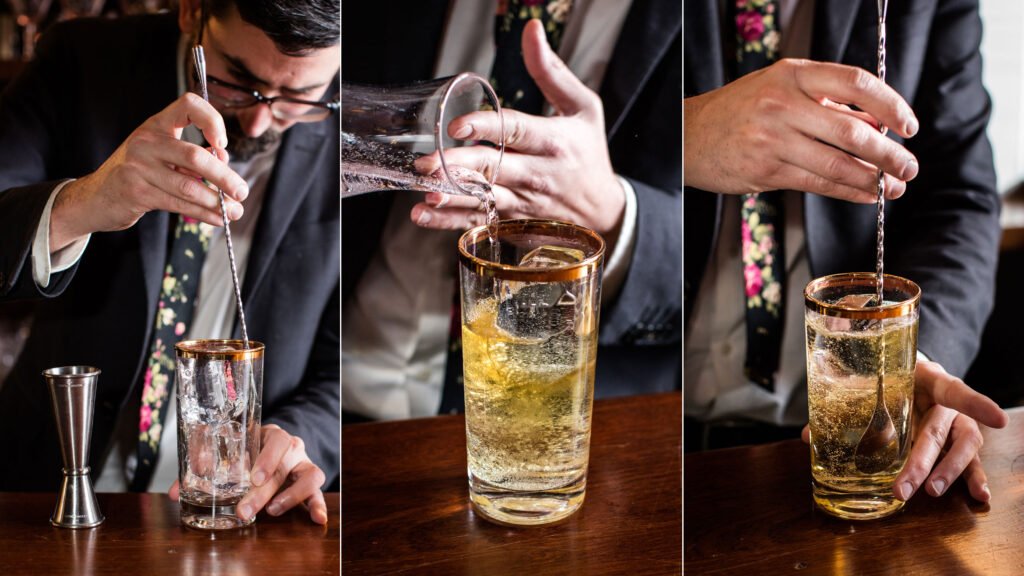“There are many small things that individually don’t make much of a difference,” explains bartender Frank Cisneros of the Japanese approach, “but holistically they become something different.” One of the latest contributors to this trans-Pacific dialogue, Cisneros spent a year behind the bar at the Mandarin Oriental in Nihonbashi, Tokyo, before returning to New York to take the helm at Karasu and Uchu, and now Bar Moga. (He remains, to this day, the only Westerner to receive a Japanese visa for the express purpose of bartending.)
While so much of what informs Japanese bartending comes from the national character—something that can’t easily be taught or translated—a primacy of technique stands at the core of this approach. “There’s less focus on speed and more focus on individual attention to each drink and each guest,” explains Cisneros, echoing a sentiment expressed by the famed Japanese bartender, Kazuo Uyeda, in his book Cocktail Techniques. “Westerners focus on results,” he writes. “While the Japanese… at heart, respect the process.”
Here, five techniques that offer a lens to understanding the Japanese style.
Hard Shake
“Every bartender develops their own shake based on the brand of cobbler shaker they use and the style of ice used at the bar,” explains Cisneros. The Hard Shake, developed by Uyeda at Tokyo’s Tender Bar, is perhaps the most well-known, partly because he is one of the few Japanese bartenders to have a book published in English outlining his philosophy and approach. Designed for maximum aeration, the intricate shaking pattern serves to efficiently integrate flavors and round out the resulting cocktail without over diluting the drink. Securing the cocktail shaker from the bottom with the fingers of one hand, and from the top with the thumb of the other, Uyeda quickly pushes the tin away from the chest before swiftly snapping it back to the original position. Combined with a corkscrew-like twist, each thrust should be accompanied by the ice hitting the bottom and top of the shaker.
Cocktails calling on egg white, cream or fruit juice are best suited to the hard shake.


Ice Cube in a Coupe
Known as Tokyo Kaikan style, a reference to the bar in which it was first seen, the practice of serving an up-drink on the rocks (or, more accurately, a rock) has been spotted at a growing number of bars. Though it was originally devised in response to the aesthetic decision to serve a Gimlet up in a Champagne coupe, rather than on the rocks—the wide opening of the glass required a single ice cube to maintain the temperature—Uyeda adapted the practice to showcase the way in which his hard shake rounded the ice cube. Present-day practitioners attest to the technique’s benefits: “It helps certain cocktails that really rely on a lower temperature to taste right to stay that way,” says Bobby Huegel. “Gimlets are a good example, because they can become cloyingly sweet when warm.”


Highball Method
The highball occupies a singular place in the world of Japanese drinks. Deceptively simple, its two ingredients require a ritual of preparation on par with that of the tea ceremony. “Japanese-style highballs are more subtle and less alcohol by volume than their western counterparts,” explains Cisneros, “Careful measuring and stirring is important, as is maintaining the bubbles, quality of ice and quality of glassware.” The best way to preserve carbonation is to pour the sparkling water so that it avoids bouncing off the surface of the ice, gently making its way between the cracks instead. In Cocktail Techniques, Uyeda also recommends chilling both the whisky and the water beforehand so as not to melt the ice too quickly.


Diamond-Cut Ice
Like many Japanese cocktail techniques, diamond-cut ice serves both a functional and aesthetic purpose. “A large cube or a sphere of crystal clear ice slows dilution,” explains Cisneros, “but in the case of a diamond it also looks beautiful.” Cisneros calls on a deba, a Japanese chef’s knife, to carve the ice block. Starting with a crystal-clear ice cube on a cutting board, he slices into one side of the ice at a 45-degree angle to form the top facet. He then places the cube top-side down and cuts down along the sides of the cube at a more obtuse angle, around 60 degrees, leaving eight facets along the sides of the diamond. He then cuts horizontally, slicing down into the cutting board at the opposite angle from the last cut, creating a grand total of 24 facets.
This technique is best suited to neat whiskey or simple whiskey cocktails, like the Old-Fashioned: “The diamond’s facets will reflect the whisky in numerous ways and allow you to admire its beauty in addition to the aroma and flavor,” says Cisneros.


Vermouth Sidecar
At his eponymous Ginza bar, Yuichi Hoshi takes a particular approach to his dry Martinis, first stirring the vermouth portion of the drink, then straining it off into a sidecar, before stirring the gin and serving the chilled vermouth alongside the dry Martini. “The sideshow is to provide a low-ABV ‘chaser’ to the drink,” explains bartender Angus Winchester, who has adapted this service for a number of menus since first observing the technique at Bar Hoshi. “Most dry Martinis in Japan are very, very dry and this gives some succor to all that dryness.” Huegel, who also endorses this practice at Anvil Bar & Refuge, concurs: “[It] takes the edge off of the Martini when desired.”


